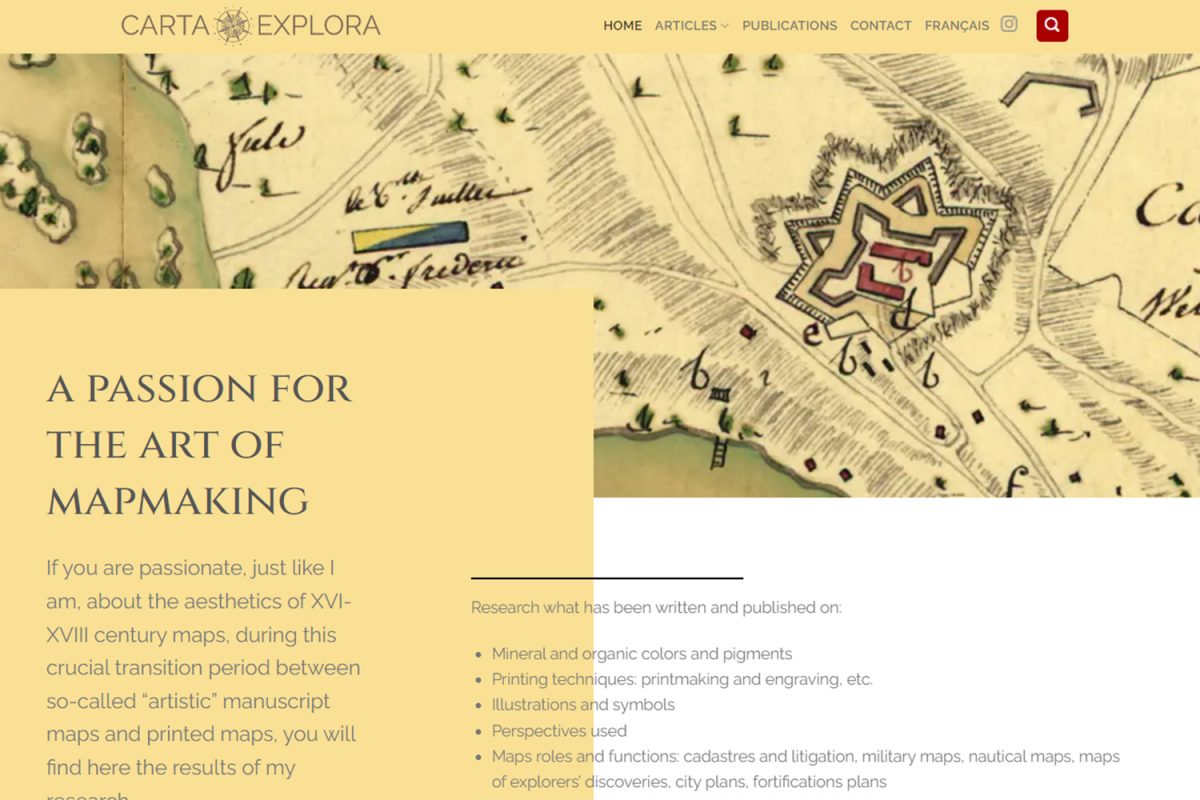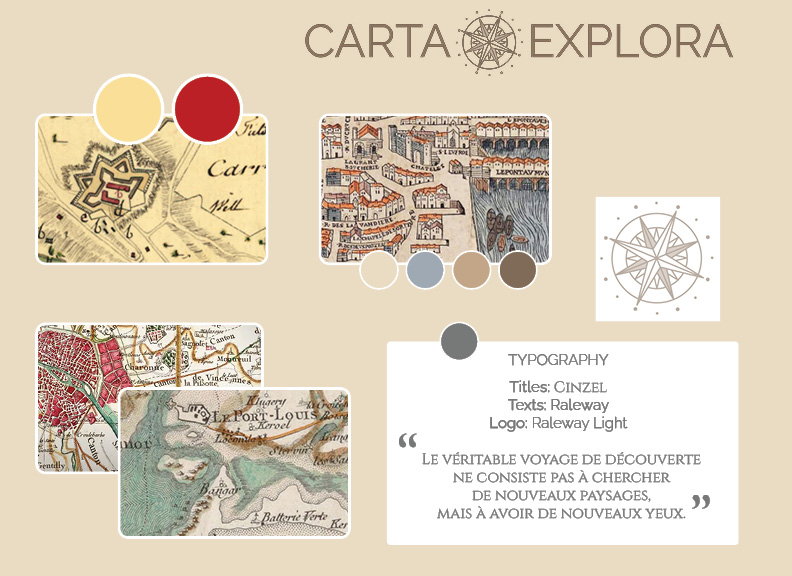See the Carta Explora project in the Portfolio section
All the stages of development and launch of this project are presented in detail below.
The Project
Carta Explora reflects a personal passion for the art in cartography, in particular 16th-18th centuries maps. First of all it is about sharing information on art and cartography in the 16th-18th centuries. Ultimately, I want to present my own artistic explorations.
The Mandate
The mandate, therefore, was to conceive the Carta Explora project and its launch from A to Z.
- The business model
- The one-page business plan
- The name
- The branding and visual identity
- The website, its sitemap and page structure, its look and feel, its functionalities, and its content
A – Choosing a Business Model
Choosing a business model is a critical decision. Too often, entrepreneurs don’t decide on a clear business model or are unrealistic about the revenues they can generate for a given level of website traffic.
Over the years, I have read many articles that all show that it takes a very high number of visitors to generate advertising or YouTube revenues. The conclusions are always the same:
- The best way to generate income is to get design contracts or project development from companies.
- The best way to get contracts is to be recommended by people who know us or are our clients. We cannot rely on our website or social media to bring us the majority of our customers.
- Give and you will receive: If you help with generosity and without the expectation of getting something in return, you can create business opportunities. One of my largest clients today comes from someone I helped in a Facebook group.
There are no articles on the web – to my knowledge – that share concrete data on the results you can expect depending on the business model you choose. But a few years ago, Convertkit/Fizzle developed a course for entrepreneurs* that provided some data. It detailed the different options (expenses and income) but I will just summarize the data here.
*Presently this course is offered by Convertkit. The content is possibly the same.
So, to earn $50,000 per year ($4,200 gross per month), here is the number of visitors, purchases, or customers that you need:
| Business Model | Marketing Reach Required |
|---|---|
| Ads on website | 1.7 million page views per month (CPM – cost per thousand – $2.80) |
| Affiliate marketing | 53,700 visitors to the affiliate page or post per month |
| E-commerce physical products (Average order of $75) |
15,500 website visitors per month (conversion rate 1%) |
| E-commerce digital product – ebook ($29) | 23,600 website visitors per month (conversion rate 1%) |
| E-commerce digital product – course ($499) | 70,000 website visitors per month (conversion rate 0.2%) |
| Services/Contracts ($1,500 project) | Approximately 3 projects per month (represents 20 hours per week, for 30-hour projects, at an hourly rate of $50/hour) |
The business model I therefore chose is to create old-style illustrated maps for historical monuments, museums, tourist agencies, or tourist book publishers. These maps will represent towns, forts, and tourist sites, or illustrate historical events.
So, to earn around $3000 net per month, it would take 2-3 projects per month and 1-2 projects to earn $2000 net per month. And I can immediately put Amazon affiliate links on the books I’m talking about, knowing that it will only bring in a few dollars, but can fund the purchase of a few books!
I also suggest that you read or watch what creators and artists are doing: Clem & Mumu, nomadic creators, (https://www.youtube.com/@ClemEtMumu), Lola Lattard, web designer (https://www.linkedin.com/in/lola-lattard-webdesigner/) and Mimimo Illustration, illustrator (https://www.youtube.com/@MimimooIllustration).
B – The One-Page Business Plan
Should you write a business plan? How long? With what level of detail?
If you are looking for financing, you will definitely need a fairly comprehensive business plan, of about thirty to fifty pages. It can take a long time to write.
But, even if you are a small business or start-up, it is essential to clearly define the key parameters of your business:
- What do you do?
- What problem are you addressing?
- Who are your customers? How would you describe them?
- Who are your competitors?
- Why buy from you rather than your competitors?
- What differentiates you from your competitors? Are these points of differentiation important/relevant factors in customer decision-making criteria?
- What competitive advantages do you have over your competition and are they hard to copy?
- What level of credibility and what evidence do you have to convince customers that the claims you make are legitimate?
- What will be your costs and sources of income?
- How does this area of activity suit you particularly well (personality, lifestyle, values)? Will you get bored or fed up?
Inspired by a one-page business plan from Convertkit/Fizzle, here are SOME of the elements of Carta Explora’s business plan:
| Carta Explora – One-Page Business Plan | ||||
|---|---|---|---|---|
PROBLEMOrganizations showcasing their cultural or historical assets need stylish, high-quality visuals that match the historical period of their venues. |
ELEVATOR PITCHPassionate about historical maps and representation of architecture, I specialize in ink and watercolor maps, conveying the style of the period, for historic sites and tourism publishers. |
SOLUTIONInk & watercolor maps featuring architecture |
||
AUDIENCEHistoric sites and tourism publishers. |
COMMUNICATION CHANNELS
|
KEY METRICS
|
DIFFERENTIATORMy passion & knowledge about historical maps & architecture representation |
REVENUESAmazon Affiliate Ink and watercolor maps $750 – $1,500 Future options: courses & physical products |
COSTSHosting ($30/month) Proofreading Subcontractor (illustrator) Travel costs Affiliate commission (30%) Payment processing (3%) |
BUSINESS BOOSTERSKnowledge of ancient cartography Passionate about the history of cartography AND artistic map creator Web content about cartography |
PERSONAL FIT
|
||
C – Choosing a Name
Choosing a name is a difficult and essential step. Indeed, the name must be easy to remember, must not be used by other companies, and must be available for social network accounts (Facebook, Instagram).
It is also useful if it contains keywords related to the field of activity because Google will take this into account.
So I chose the name Carta Explora. The name is short, easy to remember, bilingual and not used by other companies.
Carta Explora relates to both maps and explorations. Indeed, cartography in the 16th-18th centuries is often associated with the exploration of new worlds.
In addition, at that time, Latin was often used. For example, unknown lands are defined by the term terra incognita.
D – Developing a Visual Identity
![]() We must then define the colors, the typography, the emblem, and the logo. To do this, a “mood board” is an excellent tool that we can refer to throughout the development of the site and communication tools.
We must then define the colors, the typography, the emblem, and the logo. To do this, a “mood board” is an excellent tool that we can refer to throughout the development of the site and communication tools.
It allows you to visualize the various graphic elements and confirm that there is harmony between those elements.
The mood board:
For Carta Explora, the color palette reflects the colors found on 16th, 17th, and 18th-century maps and the fonts are classical.
The logo: 
The emblem is the compass rose, an element often present on maps. The logo font (Raleway Light) is modern, simple, and stylish; it is also used for texts. The font for the website headlines (Cinzel) expresses classicism. Google describes it this way: Cinzel “conveys all the ancient history of the Latin alphabet combined with a contemporary twist.”
E – Website Sitemap and Page Structure
Another key step. Indeed, having to change the website structure later will cause issues in terms of search engine optimization (404 errors).
The site map as well as the organization of the content have therefore been developed based on an in-depth analysis of the topics that I’ll cover.
I will rely on this structure when creating content for the site.
In all sections of the site (books, journals, blog articles, etc.), we find the same classification of subjects: Colors & pigments, techniques, maps & new worlds, cartographic artists, and roles of maps.
F – Developing the Website
Developed with WordPress, the site includes many functionalities: blog, portfolio, custom posts, custom fields, contact form, etc. These features allow me to clearly present the various content elements of the site: books and articles that I read, and texts that I write.
Books and journal articles are custom posts. Information such as publisher, year of publication, ISBN, or DOI are custom fields for these custom posts.
Furthermore, the site is bilingual (English / French).
And finally, some plugins are installed to ensure the site’s security, the collection of traffic data, and support for SEO (search engine optimization).
Would you like me to accompany you in the development of your project? Contact me!


